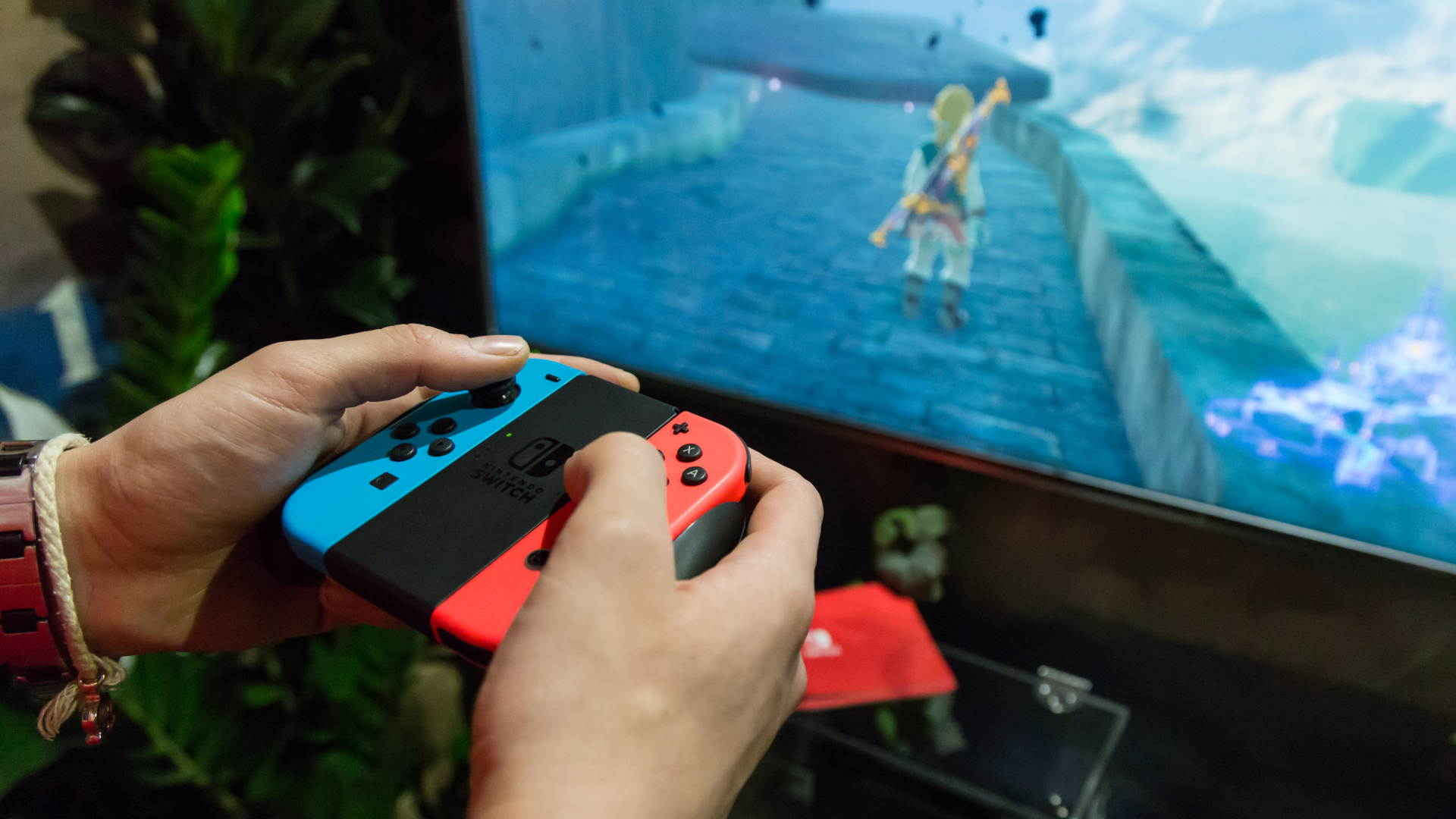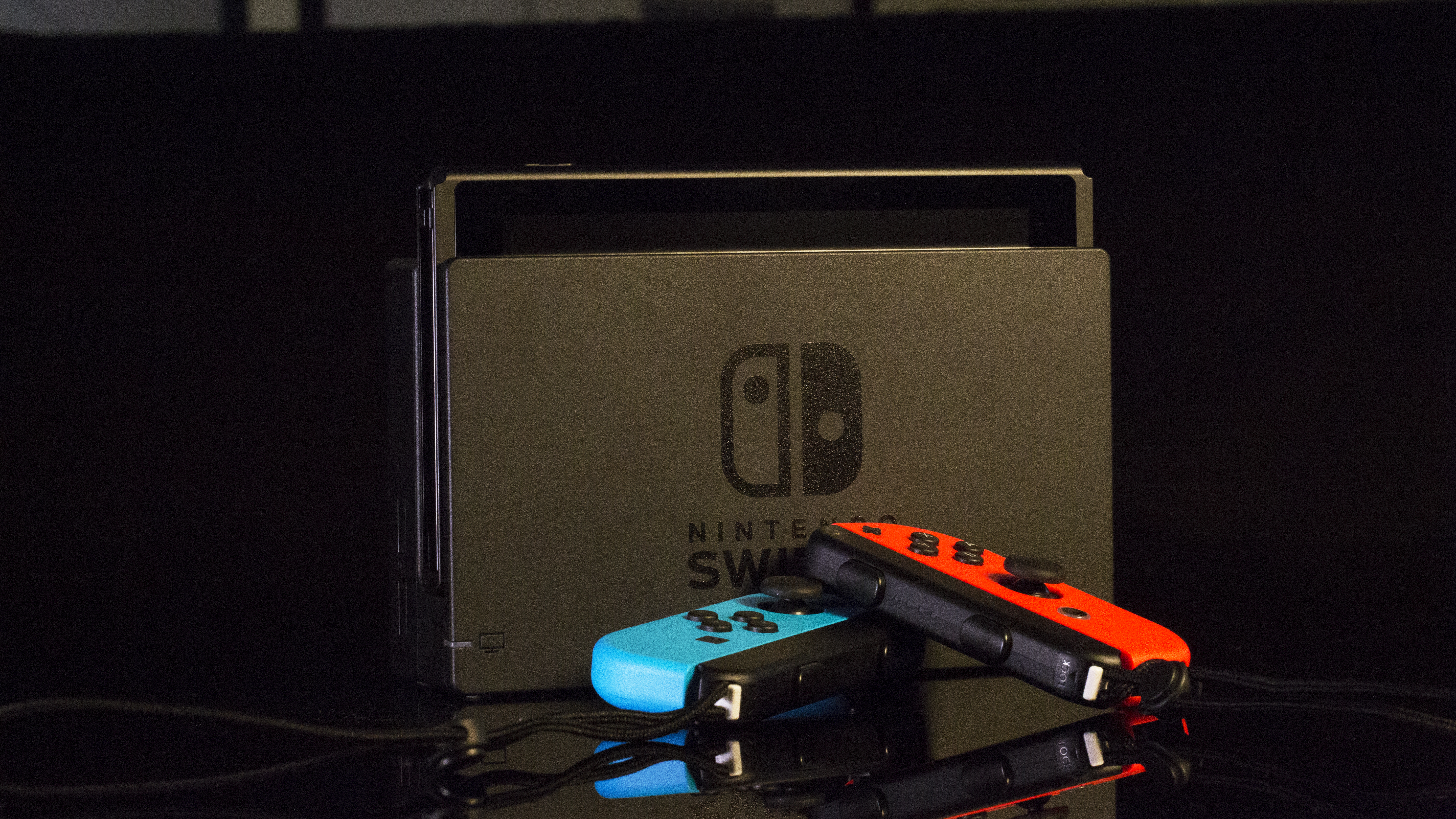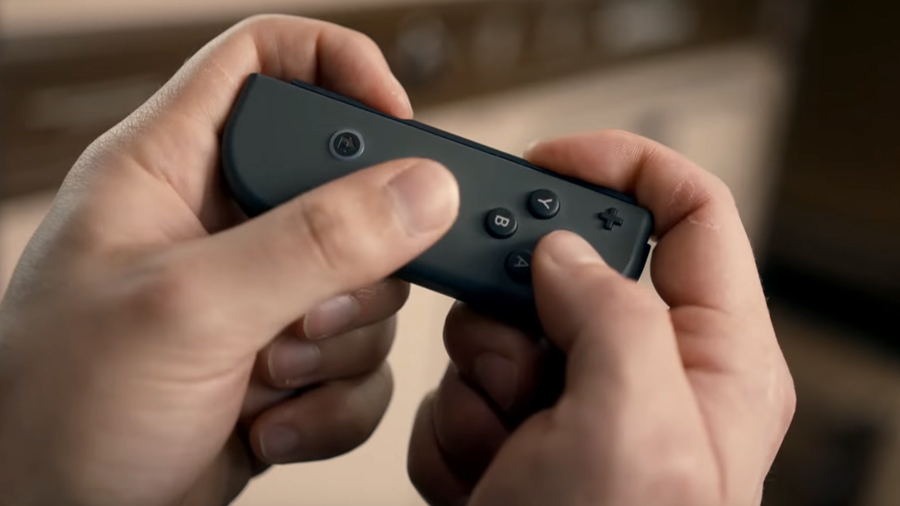Nintendo Switch Pro: everything we know about the long-rumored 4K Switch

Nintendo Switch Pro: everything we know about the long-rumored 4K Switch
A Nintendo Switch Pro has been rumored for some time, and after Nintendo released the Switch OLED, fans have waited with bated breath for the next upgrade to compete with current-gen consoles. However, despite the OLED’s sizeable upgrades over the original console with a bigger screen, redesigned kickstand, more internal storage, better speakers, and a striking OLED display, it’s not quite what players had in mind of the newest release.
The Nintendo Switch OLED‘s Achilles heel was power. It’s exactly the same as the original Nintendo Switch, released in March 2017. The console displays at 1080p when docked and 720p in handheld mode. Implementing a fancier screen made the OLED a non-essential update for anyone using their Switch when docked.
This disappointed many fans. Especially after the PS5 and Xbox Series X releases, highlighted the performance gap between Nintendo’s consoles. 4K TVs are also now the standard in many homes, which makes the Switch’s 1080p output look noticeably soft on most modern displays.
Demand for a Nintendo Switch Pro is undoubtedly there, but will we ever see a 4K Switch? What do developers want from a 4K Switch? Could existing hardware hold hints of what’s to come? Here’s everything you need to know about Nintendo’s elusive 4K console.
Nintendo Switch Pro: cut to the chase
- What is it? A souped-up Nintendo Switch capable of outputting at 4K
- How much will it cost? TBA
- When will it release? TBA
Nintendo Switch Pro: release date

The Nintendo Switch Pro was rumored to launch instead of the Nintendo Switch OLED, which landed on October 8, 2021. The existence of a Pro console has come into question, as the Nintendo Switch OLED includes many of the leaked specs that were said to be included in the Switch Pro.
Bloomberg predicted a Nintendo Switch Pro console would release around September or October 2021, which surprised many at the time. Instead, that release date belongs to the OLED model. A release date of March 2022 was hinted at, too, though this has now come and gone.
According to Tokyo-based analyst Serkan Toto, Switch Pro could still happen. Toto suggests that the Switch OLED might be a “dummy upgrade” before a real upgrade arrives next year. Speaking to Bloomberg, Toto said: “This new Switch looks more like an interim model than a real upgrade to me. This might be a dummy upgrade until Breath Of The Wild 2 is ready, and the component shortage is over next year.”
Nintendo Switch Pro: price

Redesigns cost money, more so when it involves improved hardware. The Nintendo Switch Pro, with its updated and more powerful hardware, will almost definitely cost more than the current Switch’s £279 / $299 / AU$449 pricing.
The Nintendo Switch OLED is already a more premium model and launched at $349.99 / £309 / AU$539. Thankfully this isn’t a huge step up from the original Switch’s asking price and is less than the $399 price tag that was predicted by some. For comparison, the PS4 Pro was $100 more than the PS4.
As a family-focused company, we’d be surprised if the Nintendo Switch Pro came in at the same price as PS5 and Xbox Series X, $499 / £449 / $AU749. Still, we know it’ll be more expensive than the Nintendo Switch OLED.
Nintendo Switch Pro: rumored specifications

There’s been no end of rumors about what a Nintendo Switch Pro could offer, and most suggest it’ll support 4K resolutions. A report by Bloomberg alleged that Nintendo is asking developers to make their Nintendo Switch games 4K-ready, adding weight to previous rumors that Nintendo has a resolution upgrade up its sleeve with a 4K-ready upgraded Switch console.
Bloomberg also claimed that 11 game studios had access to an official development kit that featured 4K support. Reportedly, the console was apparently shelved due to supply issues caused by the ongoing global semiconductor shortage, though it could still be released.
Nintendo, however, moved swiftly to deny these claims. In a post on Twitter, Nintendo said that Bloomberg’s report “falsely claims that Nintendo is supply tools to drive game developers for a Nintendo Switch with 4K support” the company went on to say, “we have no plans for any new model other than Nintendo Switch OLED Model.”
It’s worth noting, though, that Bloomberg’s report most notably corresponds with a recent report from the Economic Daily News, which cited various hardware manufacturers responsible for the Switch’s flash storage and Joy-Con controllers and claimed that a more powerful Nintendo Switch console with upgraded interactivity and improved display quality could go into production.
Some rumors suggested we may see a mini-LED display replace the current LCD screen. According to a report from Taiwan’s Economic Daily News, the still-rumoured Switch Pro model could sport mini-LED screens supplied by Innolux, a well-known manufacturer in the field. The original Switch and Switch Lite consoles use an HD (720p) LCD screen, though the Switch OLED naturally uses an OLED option. If a new Switch console did have 4K capability, we imagine it’d be in docked mode, with handheld mode offering a slightly-boosted Full HD (1080p) display.
Elsewhere, a data miner known as SciresM has claimed (via Wccftech) that they have found a reference to a new Nintendo Switch model within the Switch’s latest firmware update, codenamed ‘Aula’. Reportedly, this hardware uses the same chip as the Nintendo Switch Lite and 2019 Switch model, the Mariko (Tegra X1+) SoC. However, SciresM also claims that there are references to support a Realtek chip, a “4K UHD multimedia SoC”.
Rather than being within the Switch tablet, they think it “might be inside a new dock and not inside the tablet, though there’s no way to tell from the firmware code yet.” They also say that the tablet will have an improved OLED screen, though its resolution is still unclear. The claims of some 4K support do line up with the many other reports from the past year, which claim that an upgraded Switch capable of 4K is on the horizon.
More recently, we’ve seen further Nintendo Switch Pro rumours thanks to Nvidia. A leak posted to the r/GamingLeaksandRumours subreddit “confirms” the existence of the Tegra239 SoC (system on a chip). Reportedly, that’s being designed specifically for an upcoming Nintendo Switch model, which could be a Pro or full-on successor.
Of course, there’s been no confirmation from Nintendo itself that a new Switch is on the cards, and, in fact, Doug Bowser has made comments very recently that suggest there might not be for some time. With that in mind, we’re still taking all this with a pinch of salt.
Nintendo Switch Pro: news and rumors

Don’t expect new Nintendo hardware this fiscal year
Japanese financial newspaper Nikkei has reported that Nintendo will not release any new hardware this fiscal year. Spotted by Bloomberg journalist Takashi Mochizuki on Twitter, he advised that it’s unclear if Nintendo President Shuntaro Furukawa was being interviewed or Nikkei’s own reporting. If true, that means we shouldn’t expect a Nintendo Switch Pro or a Nintendo Switch 2 before March 2023.
Nintendo Switch OLED holds 4K secrets
With the Switch OLED’s launch, some of the previous consoles’ changes have started speculation that 4K capability could be hidden under our noses. For one, the console ships with an HDMI 2.0 cable – instead of the 1.4 standard used by the regular Switch – which should enable 4K passthrough from the dock or even HDR.
The Switch OLED dock contains a Realtek chip that could be 4K capable, which is new to this console – though it could be tied to other features like improved audio or Ethernet capability instead. While this isn’t a 4K console just yet, it’s possible that the dock could be used in some minimal upscaling capacity down the line or for a 4K Switch Pro when it eventually launches.

Standalone Joy-Con patent
A newly discovered patent (via VGC) suggests that Nintendo has considered some standalone Joy-Con controllers.
A newly-discovered Nintendo patent suggests that the company may be planning to release a new form of Joy-Con style controller.
Initially filed in May 2018 and registered in April 2020, the patent shows a highly similar controller shape, and layout to the existing Joy-Con found on the original Switch. However, it is slightly updated, and rather than being designed to slide onto a screen like the current Joy-Con, this controller appears to be a standalone device with no rails for sliding in sight.
While there isn’t much need for a standalone Joy-Con on the original Switch, they could be helpful with the more recent Nintendo Switch Lite, which has its controls permanently attached, as it would allow for more accessible multiplayer gaming. Given the recent rumors around the Nintendo Switch Pro, it’s also worth considering that the standalone Joy-Con has been designed with this new console in mind.
Codenames
Dataminers have been coursing through Nintendo’s firmware version 10.0.0 for information on new Switch consoles and have apparently identified codenames for the upcoming devices.
According to JershJopstin on Resetera, there are five identified codenames for Nintendo Switch models: Icosa, Copper, Hoag, Iowa, and Calcio. Here’s a breakdown of what we know about their codenames so far (thanks, TweakTown):
- Icosa – Switch released at launch – nx-abca2 – 20nm Tegra X1 –
- Iowa – revised Switch – nx-abca2 – 16nm Tegra X1 and ‘Mariko’ chip
- Hoag – the Switch Lite – nx-abcc – 16nm Tegra X1 and Mariko chip
- Copper – unconfirmed- nx-abcb
- Calcio – unconfirmed – nx-abcb – 16nm Tegra X1 and Mariko chip
While Iow, Hoag and Icosa have already released, Copper and Calcio have not been confirmed to be in development.
According to JershJopstin, Copper appears to be a non-mobile device due to its lack of battery and charging services and the HDMI services it seems to have, which would typically be handled by a Switch docking station. Meanwhile, according to another rumor, Calcio will apparently be a docked-only, more traditional console.
Nah, and official devs don’t know anything yet (at least indies). Nintendo has these archives that contain a bunch of settings for specific hardware types + there’s some configuration in various sysmodules. Nintendo often adds some or all of that before the hardware releases heh.March 2, 2020
In addition, JershJopstin has suggested that this Calcio console could be digital-only due to its apparent lack of support for game cards and the new naming form factor. However, these rumors should be treated with a healthy dose of skepticism until we get confirmation from Nintendo.
Nintendo isn’t worried about the next console generation
2020 wasn’t the year of a new Nintendo Switch console, but it was the year that Sony and Microsoft launched the next generation of consoles: the PS5 and Xbox Series X. Nintendo, however, isn’t worried about catching up.
Talking to investors during a Japanese Q&A (via VGC), Nintendo’s president Shuntaro Furukawa said that while the gaming landscape will change, the company doesn’t think the release of these next-gen consoles will have a significant impact on its own fortunes.
“We do not believe that the business trends of other companies will have a significant impact on our business,” Furukawa told investors, explaining that the reason Nintendo is so confident that the PS5 and Xbox Series X won’t pose huge competition is that the Nintendo Switch targets a different audience.
While this doesn’t tell us much about any specific new console plans Nintendo has, it does suggest that the company isn’t feeling any hurry or pressure from its supposed competitors to release, or even announce, a Nintendo Switch Pro in the immediate future.

AR and VR support
VR and AR support for the Switch never looked likely, with the MD of Nintendo France citing a lack of mainstream appeal for the technology back in 2018, but the Labo VR Kit shows Nintendo has changed its mind about the viability of VR.
The Switch doesn’t have the high resolution of most VR gaming rigs, so we could see an advanced model with 2K or 4K resolution to improve those close-up VR experiences. However, given the VR Kit is still focused mainly on children, we’d be surprised to see a visual overhaul simply for this one peripheral.
Could it support 4K?
While Sony and Microsoft push at the 4K market, there isn’t really any big reason for Nintendo, the company that staunchly sets itself apart from other hardware producers, to follow suit.
In the same interview where he dismissed VR, Nintendo France General Manager Philippe Lavoué also brushed off 4K saying that the technology has “not been adopted by the majority” and it would, therefore, be too early for Nintendo to jump in.
Nintendo didn’t enter the HD console market until 2012 when it released the Wii U. This was around four years after Sony and Microsoft and when more than 75% of US households had HD displays in their home. However, Miyamoto had said he wished Nintendo had jumped to HD sooner than this, saying that the display technology became popular around three years before Nintendo expected it to.

